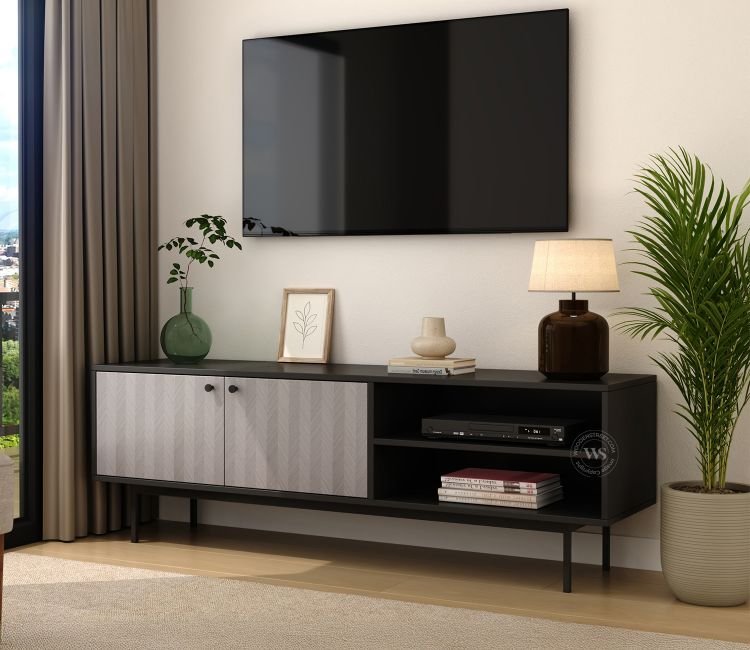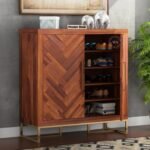Introduction
A TV unit is more than just a practical structure it anchors the entertainment zone of your living room. Choosing the right TV cabinet or TV stand involves considering material, durability, aesthetics, and budget. Two of the most common options are:
- A Wooden TV Unit (i.e., solid wood or real timber)
- A TV Unit made from Engineered Wood (e.g., plywood, MDF, particle board, or composite boards)
This article will compare these two materials in depth, assess their advantages and disadvantages, and give practical guidance on deciding which is better for your home.
What Do We Mean by Wooden and Engineered Wood?
Wooden TV Unit / Solid Wood
When we say “wooden,” we generally refer to furniture made from solid natural wood such as teak, oak, mahogany, rosewood, mango wood, sal wood, etc. The material is continuous timber through the thickness (not veneer over another core). Such units display genuine wood grain and texture.
Engineered Wood TV Unit
Engineered wood is a manufactured composite made by combining wood fibers, particles, or veneers with adhesives and pressing them into panels. Common forms include:
- Plywood layers of wood veneer glued crosswise
- MDF (Medium-Density Fiberboard)
- Particle Board / Chipboard
- HDF (High-Density Fiberboard)
- Veneered board (thin layer of real wood applied atop one of the above)
This material is widely used in furniture, cabinetry, and interior joinery because it offers uniformity and cost advantages.
Side-by-Side Comparison: Key Factors
| Factor | Wooden TV Unit | Engineered Wood TV Unit |
|---|---|---|
| Durability & Lifespan | Long-lasting; can sand and refinish scratches. | More limited; veneer restricts refinishing. |
| Stability & Warping | Prone to expansion/contraction with humidity changes. | More dimensionally stable; less likely to warp or split. |
| Cost | Premium pricing, especially for quality hardwoods. | More affordable; large panels at lower cost. |
| Weight | Heavier; requires stronger supports. | Lighter; easier to transport or mount. |
| Aesthetic & Natural Appeal | Natural wood grain, warmth, depth. | Veneered surfaces mimic wood but may lack depth or variation. |
| Repair & Refinishing | Can be sanded and refinished repeatedly. | Limited; damage may expose core material. |
| Susceptibility to Moisture | Sensitive to humidity and dryness. | Better tolerance but still vulnerable to water exposure. |
| Environmental Impact | Uses full timber; depends on sourcing. | More efficient use of wood; may use recycled content. |
| Chemical Concerns | Typically lower if low-VOC finishes are used. | Some adhesives may contain formaldehyde; choose low-VOC boards. |
When a Wooden TV Unit Shines
A wooden TV unit becomes the preferred choice in scenarios such as:
- Heirloom or Long-Term Use
Solid wood offers longevity and restoration options over decades. - Natural Look & Luxury Finish
For premium interiors, solid wood is unmatched in richness. - Repair Flexibility
Scratches and dents can be repaired or refinished easily. - Low Moisture Interiors
Climate-controlled rooms help wood remain stable. - Resale / Value Perception
Solid wood furniture often commands higher perceived value.
Where Engineered Wood Becomes Practical & Smart
Engineered wood TV units are widely used for good reason:
- Budget Constraints
Stylish and functional TV stands or TV cabinets at a fraction of the cost of solid wood. - Large Panel & Modular Designs
Ideal for modular cabinetry or large flat panels. - High Humidity / Climate Fluctuations
Stability makes engineered wood suitable for humid or coastal regions. - Customization & Surface Finishes
Easier to laminate, paint, or finish with consistent textures. - Lightweight / Wall-mounted Units
Easier to handle and install for wall-mounted setups.
Common Use Cases & Recommendations
- Premium Living Room: Solid wooden TV units provide elegance and natural appeal.
- Media Wall / Built-in Cabinetry: Engineered wood offers uniformity and versatility.
- Rental / Temporary Home: Engineered wood is affordable and flexible.
- High Humidity Locations: Engineered wood resists warping better than solid wood.
Things to Watch Out For

- Quality of Construction: Solid joinery and strong hardware matter more than material.
- Grade of Material: Opt for high-grade plywood or MDF for engineered wood units.
- Veneer Thickness: Thicker veneers improve durability.
- Moisture Protection: Seal and finish units properly to extend life.
- Weight Load: Ensure shelves and supports can handle heavy electronics.
Final Verdict: Which One Should You Pick?
The “better choice” depends on your priorities:
- Durability, luxury, and long-term value: Choose a Wooden TV Unit.
- Affordability, stability, and modular flexibility: Go with an Engineered Wood TV Cabinet / TV Stand.
A hybrid approach is also practical: solid wood for visible surfaces and corners, engineered panels for large or concealed parts. This way, you get the aesthetic appeal of natural wood with the practicality and affordability of engineered materials.


